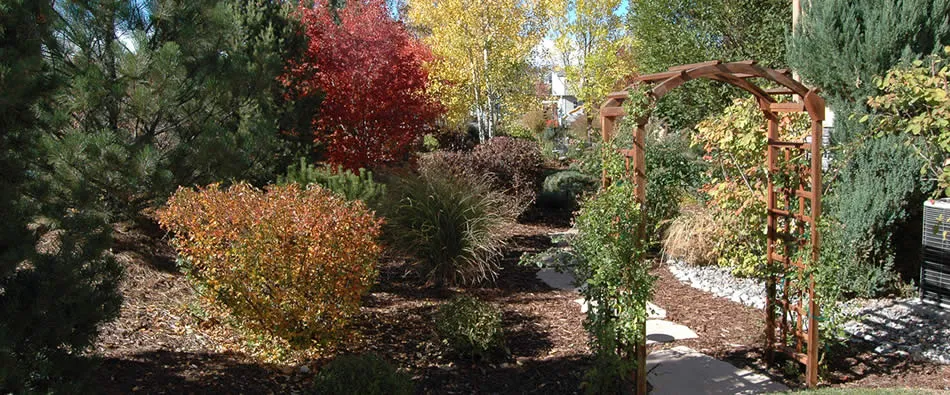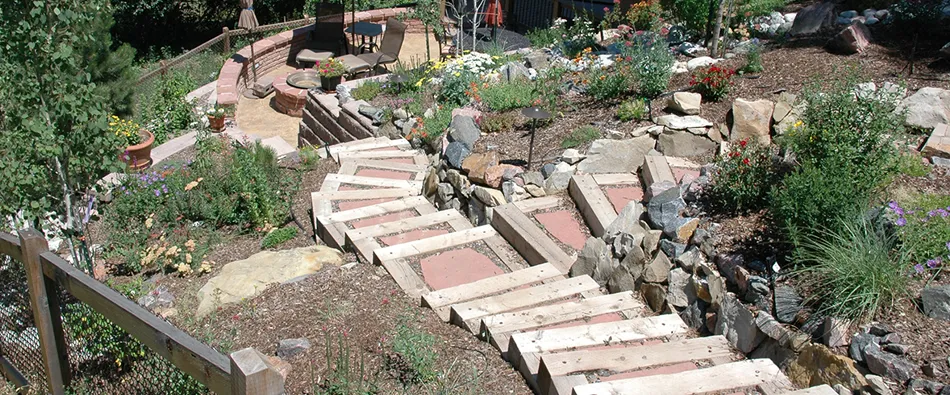Sunscald often is called southwest injury because it most often occurs on the southwest side of young tree trunks. In Colorado, it primarily occurs from December through March on young, thin-barked, deciduous trees. In other parts of the country where winter temperatures remain cold and where cloudy, sunless days prevail, sunscald occurs less frequently.
A typical winter day in Colorado may Sunscald of trees be sunny and 60 degrees Fahrenheit. High intensity sunlight, which occurs at a lower angle in the sky during the winter, heats up the south and southwest side of deciduous tree trunks. This causes cells to come out of dormancy and become active. After sunset or as weather changes, temperatures may drop below freezing. This temperature drop kills active cells and conductive tissue. Later, this injury may appear as sunken and discolored bark. Still later, this bark may crack or fall off in patches, revealing dead tissue underneath.
Young, thin-barked deciduous trees, such as honey locusts, fruit trees, ashes, oaks, maples, lindens and willows are at highest risk. Commercial tree wraps made of crepe paper insulate bark and are an effective way to prevent sunscald. In late October or early November, wrap trunks upward from the base of the tree to a point just above the lowest branches. Overlap about 33 percent with each turn. Secure the wrap with tape, but be careful not to attach the tape to the tree bark. Be sure to remove tree wrap and tape the following April to avoid girdling and possible insect damage. You may need to wrap trees each winter for several years until bark thickens and is less prone to sunscald damage.
Orchardists often whitewash or paint tree trunks white to reflect winter sunlight. While this is an effective way to prevent sunscald, it's more aesthetically acceptable in an orchard than the urban landscape.
Quick Facts…
Sunscald occurs during cold, bright days in midwinter. It occurs more frequently on thin-barked trees. Wrap trees in winter to help prevent sunscald.
Drought and overwatering injuries occur in deciduous and evergreen trees.
Plant woody plants where they can adapt to climate and soil conditions.
Woody plants have to harden off properly to prevent fall frost damage.
Damage from leaf scorch, winter drying and drought injury cannot be reversed.
Ash, aspen, honeylocust, birch and maples are the most susceptible to drowning or wet soil conditions.
Woody plants prepare for winter as fall approaches through a process called “hardeningoff”, and reach a peak of cold hardiness in midwinter.
Environmental factors that cause or contribute to drought injury include: prolonged hot, dry summer weather; dry winters; wind; soil with high salt concentrations; and restricted root growth.
Temperature extremes and rapid fluctuations can harm most plants. Because many shade trees and woody ornamentals planted in Colorado are not native, they often are injured by temperature extremes, or temperature extremes coupled with moisture stress. The five most common temperature and moisture related problems in woody plants are sunscald, drought injuries, drowning of roots, frost damage and winter (cold) damage.
Drought Injury
Drought injury is a dehydration of leaf or branch tissue that occurs when more water is lost through leaves than can be replaced through the roots. Environmental factors include prolonged hot, dry summer weather; dry winters; low relative humidity; wind; soil with high salt concentrations; and restricted root growth from too much water and compacted soil. Other factors that induce injury are construction near the tree (sidewalks, driveways, buildings); landscaping practices that use plastic as weed barriers; and soil grade changes.
Drought injury in deciduous trees most often appears as leaf scorch: areas of discolored tissue between leaf veins or along leaf margins. These irregularly shaped, discolored areas can be light tan to dark brown. Winter freezing of deciduous tree roots can result in leaf scorch the following summer.
Leaf scorch is most severe on the side exposed to the contributing factor. For example, hot, dry winds cause most symptoms to appear on the side exposed to prevailing winds. However, in some cases, heat reflected from white or light-colored siding can cause scorch, especially to conifers, even on the north side of trees. In advanced cases the entire tree appears dry and scorched. Severe scorch can result in complete defoliation because leaves dry up and fall prematurely. Trees defoliated before midsummer often form new leaves. Those defoliated in late summer may not grow new leaves until the following spring.
Winter drying of evergreens results when water lost through the needles can not be replaced by roots because the soil is dry. It often results from rapid temperature changes associated with warm, dry winds (chinooks) in late winter. Symptoms usually appear first on the south or southwest side but can develop throughout the tree. Needles of affected fir trees most often turn a yellowish color but can turn red. Spruce and pine needles turn yellow to yellow-brown and then red to reddish purple in advanced cases. Discoloration occurs first in outer branches and progresses from the needle tip to its base. In severe cases discoloration occurs rapidly and uniformly along the entire needle. A red color change on needles in early spring may indicate winter drying injury; new spring growth usually is not affected. This can be determined by checking the buds. A red color change also may indicate bark beetle or a root disease problem. If the buds are alive they will be soft and pliable.
Drought injury also occurs in evergreens during summer months. Symptoms of summer drought are evident following hot, dry weather in late summer. They include tip dieback of needles, progressing from the tree’s top downward and from outer branches inward. A severe case appears as a sudden browning of all needles. Browning and dehydration of older needles (those nearest the tree’s interior) most often is caused by a chronic drought problem but can be from natural needle drop.
Damage from leaf scorch, winter drying and drought injury cannot be reversed. Their impact on tree health, however, can be lessened or prevented by cultural practices that provide favorable growing conditions for the roots. (See fact sheet 2.926, Healthy Roots and Healthy Trees). One such practice is deeply watering the soil from the surface to a depth of 8 to 12 inches twice a month in summer and once a month in winter.
Organic mulch under trees helps reduce moisture loss and competition from turf and improves moisture penetration into the soil. Do not overwater trees and avoid polyethylene plastic under mulches. Polyethylene plastics and overwatering contribute to oxygen starvation that results in root death. A gradual yellowing of foliage that develops first on the tree’s interior and progresses outward indicates oxygen starvation.
These practices are not a guarantee against drought injury. Hot, dry summer or cold winter weather may result in excessive moisture loss regardless of how much water is provided. However, these practices help ensure a healthy tree that can better recover from drought injury.
Overwatering
Overwatering woody plants is a common problem in Colorado, particularly in irrigated turfgrass areas. Trees do not show symptoms of damaged roots from water logged soils until some time after overwatering occurs.
The most common symptom in broad-leaved trees is leaf fall in midsummer with some interveinal discoloration of the leaves. There usually is little marginal leaf scorching, since this indicates possible drought stress. The symptoms of leaf discoloration due to excess soil moisture usually start at the bottom and inside of the tree and work up, rather than from the top down as with drought stress trees. Ash, aspen, honeylocust, birch and maples are the most susceptible to drowning or wet soil conditions.
To determine how much and how often water should be applied, use a shovel to check soil moisture to a depth of 8 to 10 inches. The soil should not be crumbly or dry. If the soil feels wet or forms and holds a ball when squeezed in the hand, the soil does not need to be irrigated. If water can be squeezed from the soil or it has a sewer-gas-like odor, the soil is excessively wet.
Trees do best when there is time for the soil to drain and dry slightly between irrigations.
Frost Injury
Many woody plants are damaged by early fall and late spring frosts. Depending on the time of year, frost injury is characterized by blackening or browning of foliage or newly emerged shoots and flowers all over the plant. In areas where frost pockets develop, only the lower plant parts may be affected.
Plants are most susceptible to frost injury during the spring flush of growth. Spring frost injury often is more noticeable than fall injury, especially when new shoots of spruce droop and redden or fir shoots droop and turn light brown. Flowers also are damaged or killed on plants such as lilac and crabapple. Spring frost damage to evergreens is characterized by a downward curling of shoot tips. Affected tips may turn red or brown within one or two weeks. A severe fall frost can cause serious damage or death to parts of trees that have not hardened off.
Woody plants prepare for winter as fall approaches through a process called hardening off. They reach their peak cold hardiness in midwinter. Supplemental irrigation beyond normal lawn watering is not recommended until after fall leaf drop. Do not apply nitrogen fertilizer after mid-July. This will allow plants to harden off for winter and help prevent frost damage in early fall.
Once frost injury has occurred, nothing can be done, but frost damage can be prevented. Plant woody plants only in climates where they can adapt. For sensitive plants, avoid low areas where frosts are more prevalent.






